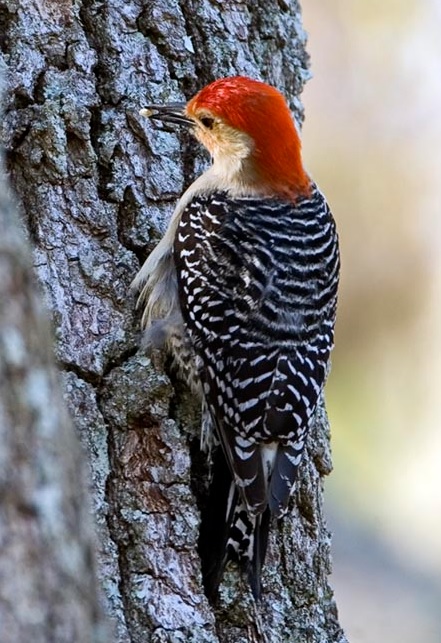A Red-bellied Invasion Remembered
Like many parents, this spring we have found ourselves perched beside baseball diamonds on breezy early evenings on many days. We enjoy watching the game and chatting with other parents. While there, we can’t also help but notice the birds. One of the noisiest birds at the local baseball field has been a red-bellied woodpecker, regularly and loudly giving its nasal “quwar” calls from an old, white oak behind the dugout.
Red-bellied woodpeckers are not well named. They have a blanket of bright red on the back of the head and generally no obvious red on the belly unless you happen to be holding one in your hand or a puff of wind fluffs the belly feathers while you’re watching at close range. The back and wings are barred black and white, and the rump is largely white. Those familiar with Maine birds would probably say it looks most similar to a northern flicker but the flicker has only a little red on the back of the head, is browner overall, shows bright yellow underwings and has some other differences as well.
We have noticed red-bellied woodpeckers at many places around Maine this spring but it was not so long ago that we would have jumped up and down with excitement to have found a red-bellied woodpecker in the state. Back in the 1980s we traveled to Machias to see the only red-bellied woodpecker known to be in Maine at that time, and we remember a contentious debate about whether the report of one identified by a few calls in Kittery should be considered a confirmed record.
Then during the fall of 2004, an unpredicted event began unfolding across northern New England and the Maritime Provinces of Canada, thrilling seasoned birders and casual bird-feeding enthusiasts alike. It began with an out-of-range red-bellied woodpecker reported to the Maine birding list serve. This single report was quickly followed by another, then another, then another—dozens of them appeared across a region extending from the Adirondacks of New York eastward to New Brunswick and Nova Scotia. Soon it was clear that this was not just the normal handful of wayward birds. It was, in fact, the largest and most widespread invasion of red-bellied woodpeckers ever documented.
By December of 2004 at least 150 out-of-range birds had been reported across the region. These included at least 100 from Maine, 20 from Nova Scotia, and 22 from New Brunswick. More than 50 of the reported Red-bellies occurred greater than 100 miles from the nearest previous breeding area, with the long-distance travel record going to a bird found in New Glasgow, Nova Scotia some 450 miles from the species’ range edge!
As in most such unusual invasion events, we know little about the origin of the pioneering birds. A reasonable assumption is that they were birds born the summer before who were making their first dispersal movement to find new, unoccupied places to set up territories. But why strike out across such a far flung region outside of the normal breeding area?
We may never know, but now more than a decade after the invasion event, red-bellied woodpeckers have established themselves as breeders over much of southern and coastal Maine and occasionally farther north. Some things do change, but parents watching baseball games in spring may go on forever—even if not all of them are watching for birds too!
Jeffrey V. Wells, Ph.D., is a Fellow of the Cornell Lab of Ornithology. Dr. Wells is one of the nation's leading bird experts and conservation biologists and author of the “Birder’s Conservation Handbook.” His grandfather, the late John Chase, was a columnist for the Boothbay Register for many years. Allison Childs Wells, formerly of the Cornell Lab of Ornithology, is a senior director at the Natural Resources Council of Maine, a nonprofit membership organization working statewide to protect the nature of Maine. Both are widely published natural history writers and are the authors of the book, “Maine’s Favorite Birds.”
Event Date
Address
United States

























